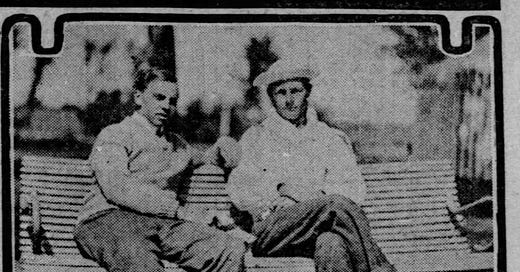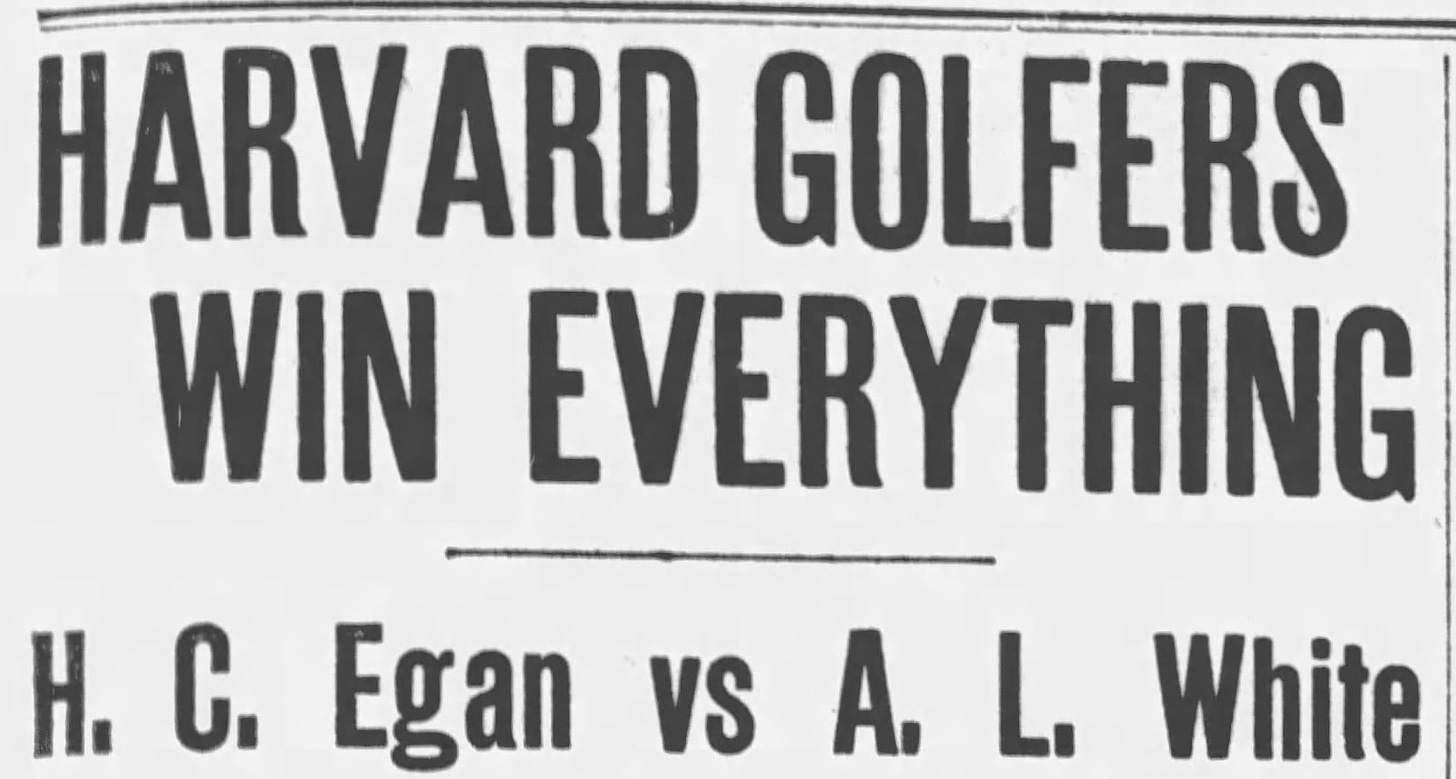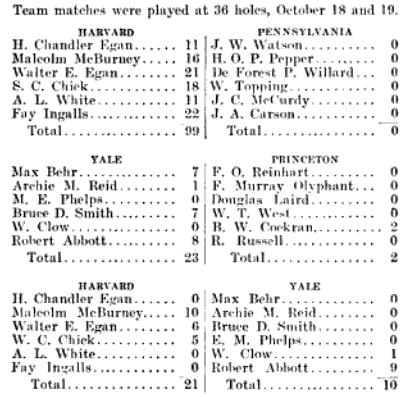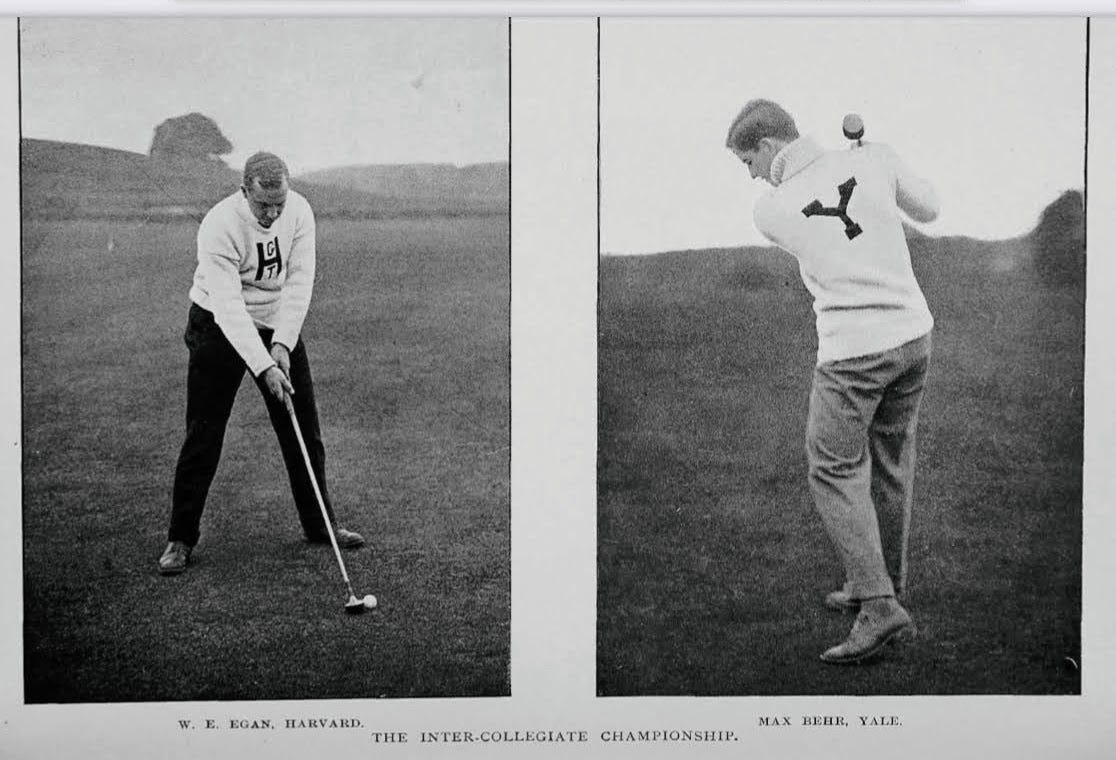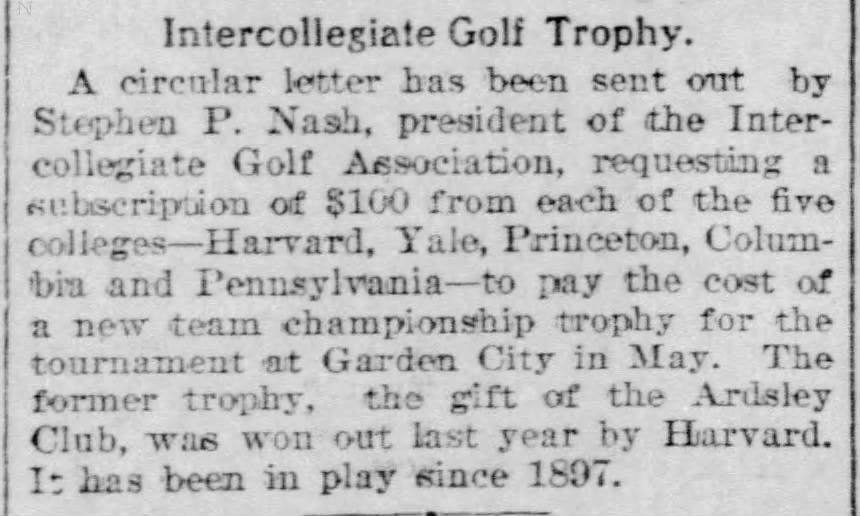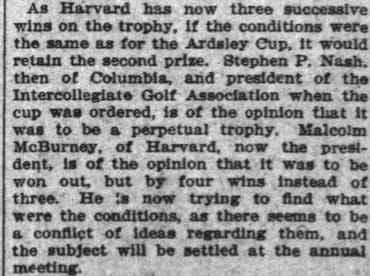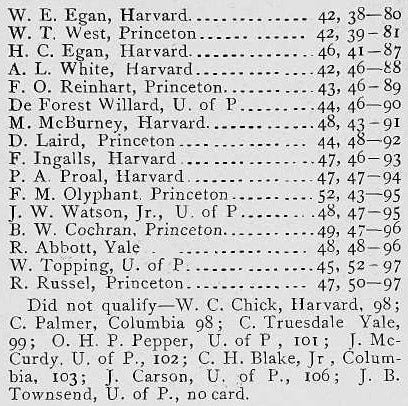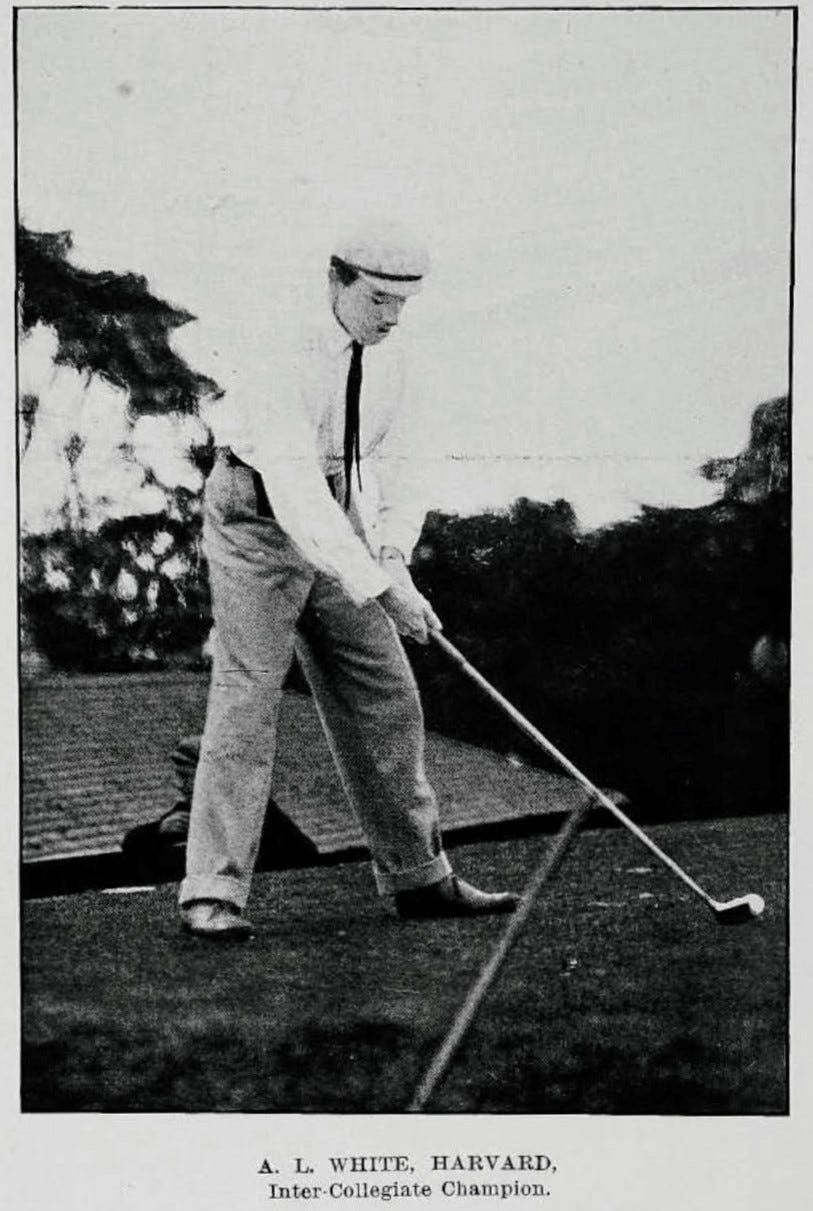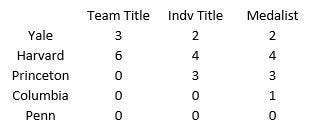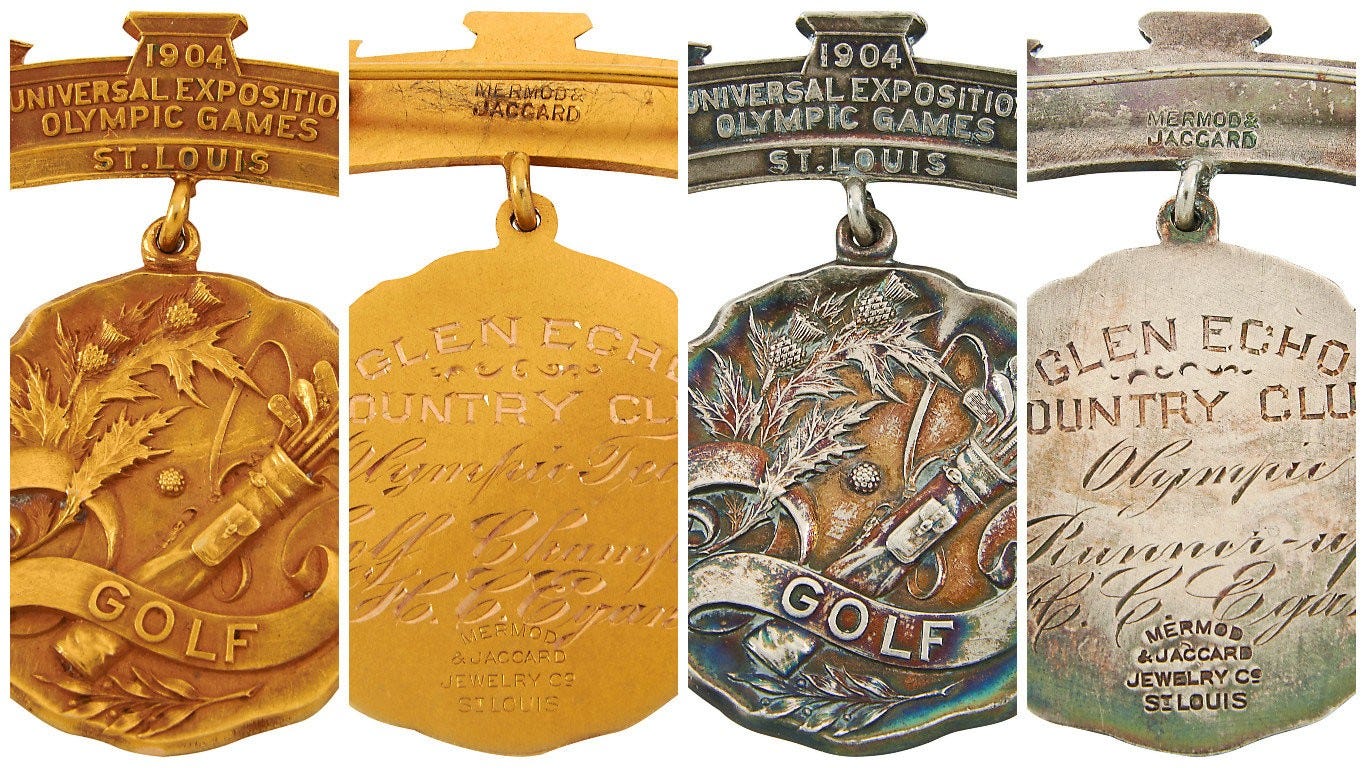This is part of a series on the Men’s Collegiate Championships
IGA Championship Era: 1897-1938
1904 was an incredible year for Harvard, even before the start of the intercollegiate championship. One Harvard man in particular, (Henry) Chandler Egan, was having what can only be described as a dominant season, winning the Western Amateur, US Amateur, and multiple Olympic medals, all within a three month span. Riding that momentum to their home course, everything was set up for Harvard to cap off the year with more gold and silver hardware.
Intercollegiate Championship #: Oct 18-22, 1904
Host: Myopia Hunt Club (Boston, MA)
Harvard is finally successful in getting local Myopia to host the Intercollegiate championship
Format
Team match play (4 teams, 6 players each, random draw, 36 hole matches)
Individual stroke play qualifier (18 holes)
Individual match play (16 players, also random draw, 18 hole matches)
Results
Team Champ: Harvard (6)
The bracket was simplified this year with only four teams making the trip. Neither of the semifinal matches were particularly close, setting up another epic Finals match between Harvard and Yale. Although the final result was heavily in Harvard’s favor, the incredible match between Chandler Egan and Max Behr - Yale’s first graduate to design golf courses and first editor of Golf Illustrated - was ultimately halved. There were no weak spots in the Harvard line-up which consisted of Chandler and Walter Egan, WC Chick, Malcolm McBurney, AL White, and Fay Ingalls. This was as close to a murderers row as college golf had seen to this point which constituted the standard against which the future “greatest teams” were first measured against.
Harvard’s win in 1904 was their third (in four championships) since winning the Ardsley Cup in 1901. This win brought to head an ugly controversy that would have interesting consequences. After the Ardsley Cup was won, the IGA immediately set out to replace the trophy with another to be awarded to the annual-ish team winner. Each of the IGA member teams were billed $100 (~$3k in 2023 money) to contribute towards this trophy which was soon put into play. At the time of Harvard’s third win, the IGA was still paying off the trophy which had actually cost somewhere around $600, so there was fierce pushback to Harvard believing they would get to permanently keep the trophy under the same conditions they had won the Ardsley Cup. The IGA President at the time of purchase believed the trophy was a perpetual one (couldn’t be kept), but since written proof of those conditions couldn’t be found, the current IGA President - Harvard’s Malcolm McBurney - was put into a tough spot. His suggestion that perhaps it was supposed to be four wins surely was a form of appeasement, but it appears that the matter was still not resolved by the 1905 championship. Two fortunate (depending on your perspective) things happened in 1905: the USGA announced they were donating a perpetual team trophy to the IGA, and Yale won the 1905 team title. Just as that can was effectively kicked down the road, so too will we do a little kicking and explore the outcome of this in the next post.
Medalist: Walter Egan [Harvard]
Of course it figures that a Harvard man would win medalist honors on the home course, and in fact the only member of the championship Harvard team not to make match play was reigning runner-up, WC Chick. Every bit the serious and capable golfer as his cousin, Walter blitzed the back 9 to edge out Princeton’s WT West and preserve the potential (preordained?) award sweep.
Individual Champ: Alverse L White [Harvard]
On his way to the Finals he seemed destined to win, Chandler Egan cleared his biggest hurdle by defeating the reigning 1903 individual champ Frank Reinhart [Princeton]. It was here that the magical run finally ended for Egan, losing out another member of the championship-winning Harvard team, which seems like the only palatable loss. On the surface this seems like a major upset with AL White beating his nationally celebrated teammate. In fact, Chandler wasn’t the only Harvard teammate White took down on the way to the individual title, also defeating Walter Egan and then Malcolm McBurney. It’s clear that despite it not being the storybook ending, this was a well deserved title and perhaps a bit more fitting considering the team aspect of collegiate golf.
Championship Award Count
The Egans
In the 4 championships that Harvard’s Egan cousins played (Spring 1902-1904), they collectively won 3 team titles, 1 medalist honor, and 1 individual title. Simultaneous to this, they won a plethora of other amateur and club titles. Among the largest wins for Chandler included the 1904 US Amateur (and his defense a year later) and the 1902 & 1904 Western Amateur (he would go on to win in 1905 and 1907). Walter had finished as the Western Am runner-up in the very first event held in 1899 as well as 1902 (to Chandler), but would get revenge by winning the 1903 title over his cousin. His best finish in the US Amateur was a runner-up finish in 1901, Walter Travis gaining the repeat win at Atlantic City CC.
Along with leading Harvard to glory, the Egans found success in other team golf events representing “Western” golf and even the nation by winning Olympic gold medals (see below). The Harvard teams these two men led, especially the 1904 team above, were considered the gold standard that future teams were measured against for decades to come.
EXTRA HOLES: Olympic Golf (1904)
The 1904 Olympics was just the second time golf was played (1900, Paris, France), but the first one actually accessible to some/most United States amateurs that compete on the national stage. Held at Glen Echo CC in St Louis on Sep 17-24, these events happened barely a week after the conclusion of the US Am and a month before the Intercollegiate championship. Check out this article for a detailed account.
Chandler Egan performed extremely well across the board, earning a gold medal with the team from the WGA and the silver medal in the individual competition.
Representing the Western Golf Association, one of three 10-man teams to enter along with the Trans-Mississippi Association and Team USA (hastily put together team of players in the area at the time), Chandler Egan was only one of a handful of youthful collegians that earned a gold medal. Others to take note of include his cousin and Harvard teammate Walter Egan, Mason Phelps [Yale], and a young Robert “Bob” Hunter who in SIX years would factor heavily on a superstar Yale team (which we will cover soon).
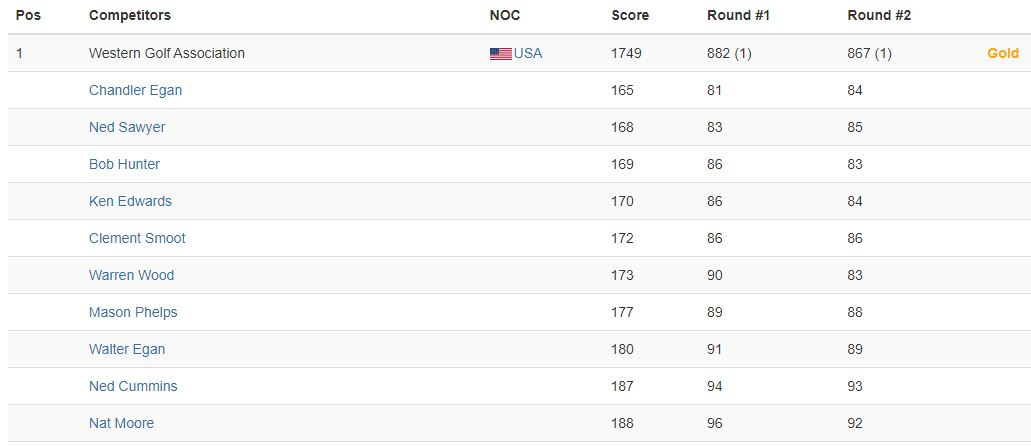
Thanks for reading!
Up Next:
In the next post we will cover the 1908 championship which saw numerous format changes, new teams added to the IGA, and more trophy drama.

